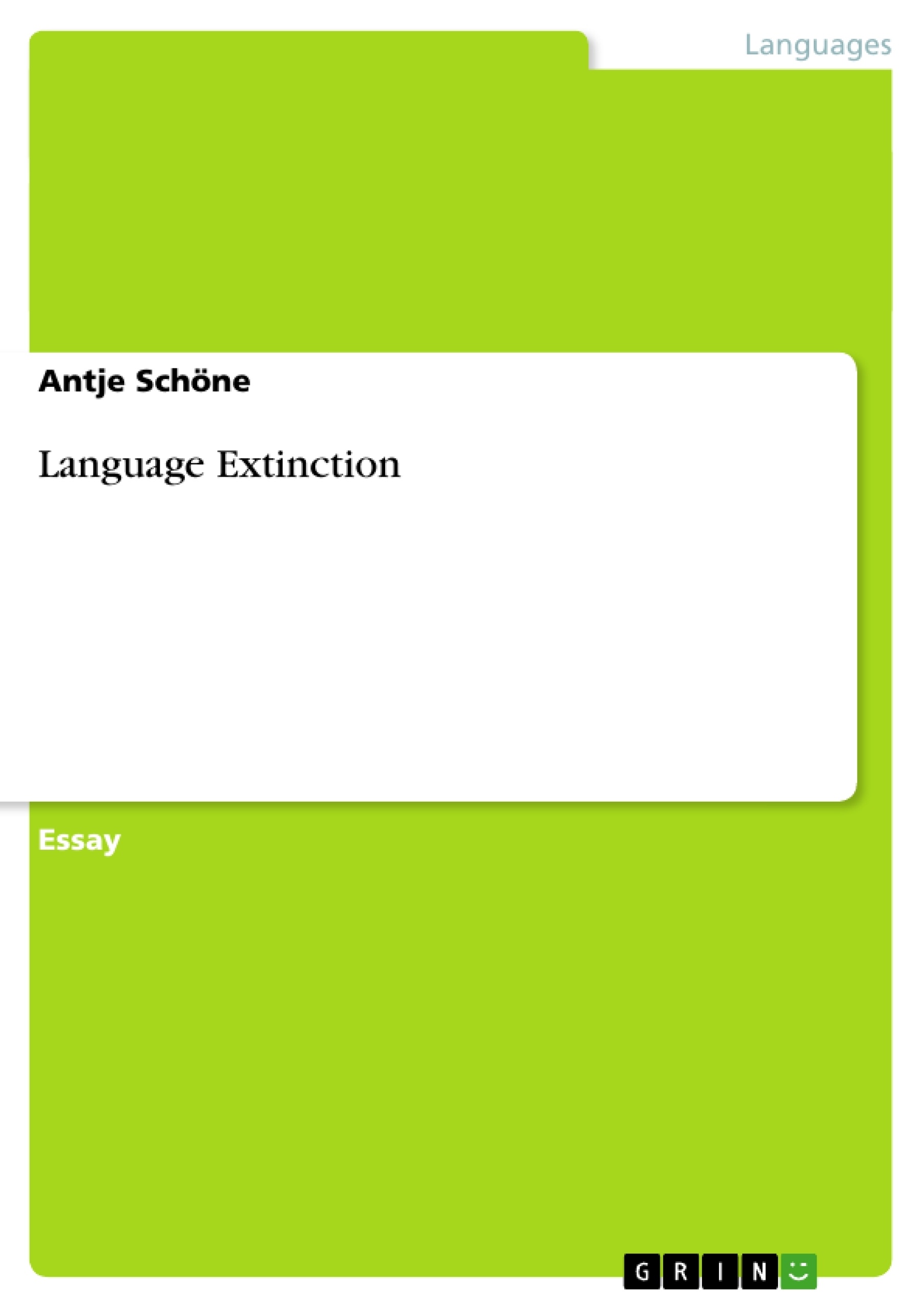Excerpt
TU Dresden WS 07/08
Institut für Anglistik und Amerikanistik
Professur für Anglistische Sprachwissenschaft
.
AQua – Bereich B: Kommunikative Kompetenzen und Medienkompetenz
Presenting Language Topics
Essay: Language Extinction
“Humans speak more than 6,000 languages. Nearly all of them could be extinct in the next two centuries. So what?”, writes the Science Daily in 2007.[1] Language death is an explosive topic. But what causes language decline and why does it matter?
A language is considered to be dead when the last, or even second to last person who speaks it dies. “90 percent of existing languages today are likely to die or become seriously embattled within the next century. That leaves only about 600 languages, 10 percent of the world's total, that remain relatively secure for now”, confirm linguists.[2] 96 percent of the world’s languages are spoken by only four percent of the population.[3] These small groups are faced “a complex of internal and external pressures that induce [their] speech community to adopt a language spoken by others”. This phenomenon is called language shift.[4]
External influences on language death come from dominant language speakers, not being aware of or appreciating smaller indigenous language groups. Many social policies used to and still do restrict rather than support language minorities. For example the Native American Languages in the United States: At the end of the 19th century they established new guidelines for Indian communities as they presumed their ‘barbarous dialects’ were the cause of all conflicts between the Indians and Americans. Schools for Indian children were established where they were told that any Indian custom is uncivilized and “were taught to despise every custom of their forefathers, including religion, language, songs, dress, ideas [and] methods of living”.[5]
On the other hand is the internal influence which is when children don’t learn the language or dialect of their parent’s any longer. This happens when bi- or multilingual parents don’t regard it necessary for their children to learn ‘a low-prestige language variety’. Furthermore, the children themselves are not motivated much when using the ‘dominant language’ is more profitable.[6]
That leads us to the question why we should take the time and make the effort to preserve indigenous languages. Having only a few languages spoken in the world would mean losing linguistic diversity and thus loosing diversity in ideas. The wider understanding of language development and grammatical and phonological varieties would be not as great with fewer languages. Also, it implies losing an enormous variety of possibilities of how to understand the world around us, as a language is an important part of cultural studies.[7]
These arguments are from a scientific point of view, but there is also a moral obligation of preserving languages: “A language is the culmination of thousands of years of a people’s experience and wisdom”.[8] It carries ‘a rooted identity’ and values that are very important to the native speakers.[9]
Last question then is: how can we preserve the indigenous languages? First of all, it is a human right to have and speak your own language. Therefore, public language policies need to be changed. This has happened, regarding the previous example of Native American Languages: acts were finally passed in the 1990s to protect the Indian dialects. To achieve this, attitudes of dominant speakers have to be changed. And also the public needs to be made more aware of the advantages of multi-lingual cultures.
To conclude, people need to be aware of the fact that languages can and are dying; on average one language disappears every two weeks.[10] It is a topic that affects many of us directly or indirectly sooner or later. And everyone can help to preserve languages especially in times of new media like the internet. Only 10 percent of the world's languages are represented on the Internet.[11]
[...]
[1] ScienceDaily. “Linguistics Expert Warns Of Language Extinction“. 04. March 2007. University of Toronto. 05. February 2008. <http://www.sciencedaily.com/releases/2007/02/070218140348.htm>
[2] Crawford, James. “Endangered Native American Languages: What Is to Be Done, and Why?”. James Crawford’s Language Policy Web Site & Emporium. 1998. USA. 05. February 2008 <http://ourworld.compuserve.com/homepages/JWCRAWFORD/brj.htm>
[3] MongaBay.com. “Does language extinction matter?“. 16. February 2007. San Francisco, USA. 05. February 2008. <http://news.mongabay.com/2007/0215-language.html>
[4] Crawford, James. 1998
[5] Crawford, James. 1998
[6] Crawford, James. 1998
[7] Crawford, James. 1998
[8] Shigemoto, Joan. “Language Change and Language Planning and Policy“. PREL Briefing Paper. Pacific Resources for Education and Learning. 1997. Honolulu Hawaii. 05. February 2008. <http://www.prel.org/products/Products/language-change.htm>
[9] Crawford, James. 1998
[10] Science Daily. 2007
[11] MongaBay.com. 2007
- Quote paper
- Antje Schöne (Author), 2008, Language Extinction, Munich, GRIN Verlag, https://www.grin.com/document/111733
Publish now - it's free






















Comments